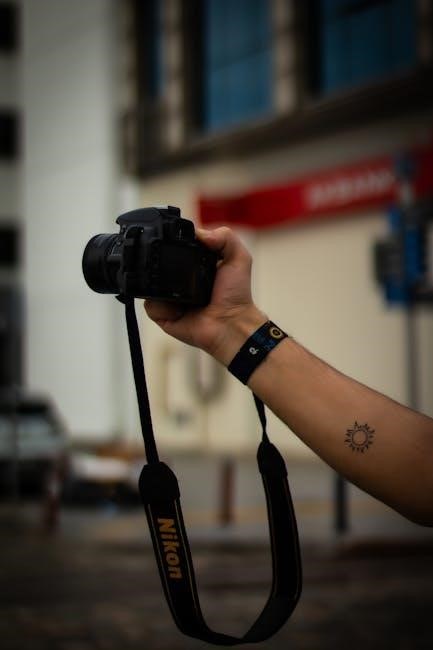The Nikon D80 user manual is a comprehensive guide designed to help photographers unlock the full potential of their camera. It covers basic operations, advanced features, and troubleshooting, ensuring both new and experienced users can master the D80’s capabilities effectively.
Overview of the Nikon D80 Camera
The Nikon D80 is a 10.2-megapixel DSLR camera designed for both beginners and professional photographers. Released in 2006, it features a CCD sensor, a 2.5-inch LCD display with 230,000 pixels, and a built-in flash for convenience. The camera is known for its robust build quality, intuitive controls, and user-friendly interface, making it a popular choice for those transitioning from entry-level to advanced photography. The D80 supports various shooting modes, including Auto, P, S, A, and M, offering flexibility for different photographic scenarios; Its compact design and ergonomic layout provide easy access to key functions, while the manual ensures users can fully utilize its capabilities. This camera remains a favorite among enthusiasts for its balance of performance and accessibility.
Importance of the User Manual
The Nikon D80 user manual is an essential resource for unlocking the camera’s full potential. It provides detailed instructions on operating the camera, from basic functions to advanced features, ensuring users can make the most of its capabilities. The manual is particularly valuable for beginners, offering a clear guide to understanding the camera’s layout, shooting modes, and customization options. For experienced photographers, it serves as a reference for troubleshooting and exploring advanced techniques. Regular consultation of the manual reinforces understanding and reveals new functionalities, enhancing photographic skills. Keeping the manual accessible is strongly recommended, as it empowers users to overcome challenges and capture stunning images with confidence. Its comprehensive insights make it a cornerstone for mastering the Nikon D80.
Downloading the Nikon D80 User Manual
Downloading the Nikon D80 user manual is a straightforward process that ensures you have access to a wealth of information to maximize your camera’s potential. The manual is available in PDF format from Nikon’s official website, providing a reliable and secure source. Additionally, reputable photography websites and forums may host copies of the manual for easy access. When downloading, it’s crucial to verify the authenticity of the source to avoid malware or incomplete documents. Having the manual in digital form allows for easy reference and portability, ensuring you can troubleshoot or explore features wherever you are. Regularly consulting the manual helps users unlock advanced functionalities and maintain optimal performance of their Nikon D80.

Nikon D80 Camera Specifications
The Nikon D80 features a 10.2 MP CCD sensor, 2;5-inch LCD, and built-in flash. Released in 2006, it remains a durable and versatile DSLR with robust twin dial controls.
Key Features of the Nikon D80
The Nikon D80 boasts a 10.2-megapixel CCD sensor, delivering high-quality images with excellent detail and color accuracy. Its 2.5-inch LCD screen offers a clear view for previewing shots. The camera features an 11-point autofocus system for precise subject tracking and a built-in flash for added versatility. It supports a wide range of Nikon lenses and accessories, making it adaptable to various shooting needs. The D80 also includes advanced metering modes and customizable settings, allowing users to tailor their photography experience. With its durable construction and intuitive controls, the Nikon D80 remains a reliable choice for both amateur and professional photographers.
Sensor and Image Quality
The Nikon D80 features a 10.2-megapixel CCD sensor, designed to capture high-resolution images with excellent detail and color accuracy. The sensor delivers crisp and vibrant photos, making it suitable for a variety of photography genres. With an ISO range of 100 to 1600, the D80 performs well in both bright and low-light conditions, offering flexibility for different shooting scenarios. The camera’s image processing system ensures minimal noise, especially at lower ISO settings, resulting in clean and professional-looking images. Additionally, the D80 supports various image formats, including RAW and JPEG, allowing users to choose the best option for their needs. The combination of the CCD sensor and advanced image processing makes the Nikon D80 a reliable choice for photographers seeking high-quality imagery.
LCD Display and Viewfinder
The Nikon D80 is equipped with a 2.5-inch LCD display featuring 230,000 pixels, providing a clear and detailed view for image review, menu navigation, and setting adjustments. The LCD screen is bright and color-accurate, making it ideal for assessing image quality and fine-tuning camera settings. The camera also features a pentaprism optical viewfinder, offering a wide 95% frame coverage for precise composition and focus. The viewfinder is equipped with a diopter adjustment to accommodate users with vision impairments. Together, the LCD display and viewfinder provide flexible and intuitive ways to compose and review images, enhancing the overall shooting experience. These features ensure that photographers can work efficiently, whether in the studio or on location.
Built-in Flash and External Flash Options
The Nikon D80 features a built-in flash with a guide number of 12, offering convenient lighting for everyday photography. It supports i-TTL flash control, enabling precise exposure in various lighting conditions. The built-in flash can also serve as a commander for wireless off-camera flash units. For enhanced creativity, the D80 is compatible with Nikon’s Creative Lighting System, allowing use of external Speedlight flash units. External flashes provide greater flexibility, enabling bounced light and more control over illumination. The user manual details how to adjust flash settings, such as flash compensation and synchronization modes, ensuring optimal results. Whether using the built-in flash or external units, the D80’s flash system offers versatility for diverse photographic needs, making it a robust tool for both casual and professional shooting scenarios.

Navigating the Nikon D80 User Manual
The Nikon D80 user manual is structured to guide users through camera operations, features, and troubleshooting seamlessly. Its clear organization ensures easy access to essential information for photographers of all levels.
Structure and Organization of the Manual
The Nikon D80 user manual is meticulously organized to ensure easy navigation and comprehension. It begins with an introduction to the camera’s basic features, followed by detailed sections on shooting modes, menu navigation, and custom settings. Each chapter is logically structured, guiding users from fundamental operations to advanced techniques. The manual includes clear headings, bullet points, and diagrams to enhance readability. Troubleshooting and error messages are addressed in dedicated sections, providing quick solutions to common issues. The manual’s systematic approach allows users to progressively learn and master the camera’s capabilities, making it an indispensable resource for photographers of all skill levels. Its clear organization ensures that users can quickly find the information they need, optimizing their photographic experience.

Understanding Icons and Symbols
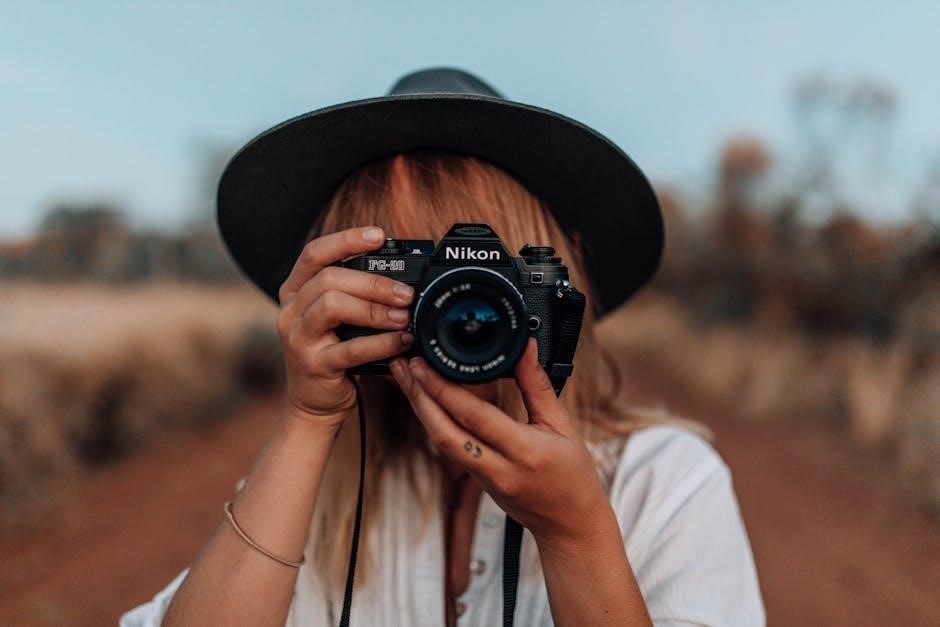
The Nikon D80 user manual uses a variety of icons and symbols to represent different camera functions and settings. These visual cues are designed to help users quickly identify and understand key features. For instance, icons for shooting modes, such as Auto, P, S, A, and M, are prominently displayed, while symbols for focus modes and flash settings are clearly explained. The manual also includes diagrams that illustrate how these icons correspond to physical buttons and controls on the camera. By familiarizing oneself with these symbols, users can navigate the camera’s interface more efficiently and make adjustments without unnecessary delays. This visual guide is particularly useful for beginners, as it simplifies the learning process and enhances overall usability. The consistent use of icons ensures a seamless and intuitive experience for photographers of all skill levels.
Quick Start Guide for Beginners
The Nikon D80 user manual includes a Quick Start Guide designed to help new users get acquainted with the camera’s basic functions. This section provides step-by-step instructions for unboxing, initial setup, and preparing the camera for use. It covers essential tasks such as charging the battery, inserting the memory card, and familiarizing oneself with the camera’s controls. The guide also explains how to set the date, time, and language, ensuring a smooth initial setup process. For beginners, the manual emphasizes the importance of understanding the camera’s shooting modes, such as Auto Mode, which simplifies photography for those new to DSLRs. By following the Quick Start Guide, users can quickly begin capturing images while gaining confidence in their ability to operate the camera effectively.

Basic Camera Operations
The Nikon D80 user manual details fundamental operations, including initial setup, camera modes, and menu navigation, helping users master essential functions for capturing stunning images effortlessly.
First Steps: Unboxing and Initial Setup
Unboxing the Nikon D80 is an exciting first step in your photography journey. Inside, you’ll find the camera body, rechargeable battery, battery charger, neck strap, and Eyepiece Cap. Before powering on, ensure the battery is fully charged using the provided charger. Once charged, insert the battery into the camera’s grip compartment. Next, attach the neck strap for secure handling. If using a lens, mount it by aligning the white dots on the lens and camera, then twisting clockwise until it clicks. Finally, set the language, date, and time via the menu system. The manual guides you through these initial steps, ensuring a smooth setup process. For new users, the Quick Start Guide is particularly helpful, providing a concise overview to get you shooting quickly. Proper setup ensures optimal performance and prepares you to explore the D80’s features.
Understanding Camera Modes (Auto, P, S, A, M)
The Nikon D80 offers five primary camera modes: Auto, Program (P), Shutter Priority (S), Aperture Priority (A), and Manual (M). Auto mode is ideal for beginners, as it automatically adjusts settings for point-and-shoot simplicity. Program mode (P) offers more flexibility, allowing users to adjust settings while the camera still manages exposure. Shutter Priority (S) lets you set the shutter speed, useful for capturing motion or freezing action. Aperture Priority (A) enables control over aperture for adjusting depth of field. Manual (M) mode provides full control over both aperture and shutter speed, ideal for advanced photographers. The user manual explains each mode in detail, helping you choose the right one for your shooting scenario and improve your photography skills effectively.
Basic Playback and Menu Navigation
Mastering basic playback and menu navigation on the Nikon D80 is essential for efficiently reviewing and managing your photos. The camera features intuitive controls that allow you to scroll through images, delete unwanted shots, and access playback options like slideshow and zoom. The user manual provides detailed instructions on how to navigate the menu system, enabling you to customize settings and optimize your shooting experience. Key functions include reviewing images on the 2.5-inch LCD screen, using the multi-selector to scroll through photos, and accessing menu options for adjusting image playback settings. The manual also explains how to utilize the camera’s built-in help system for guidance on specific features. By familiarizing yourself with these basics, you can streamline your workflow and focus on capturing stunning images.
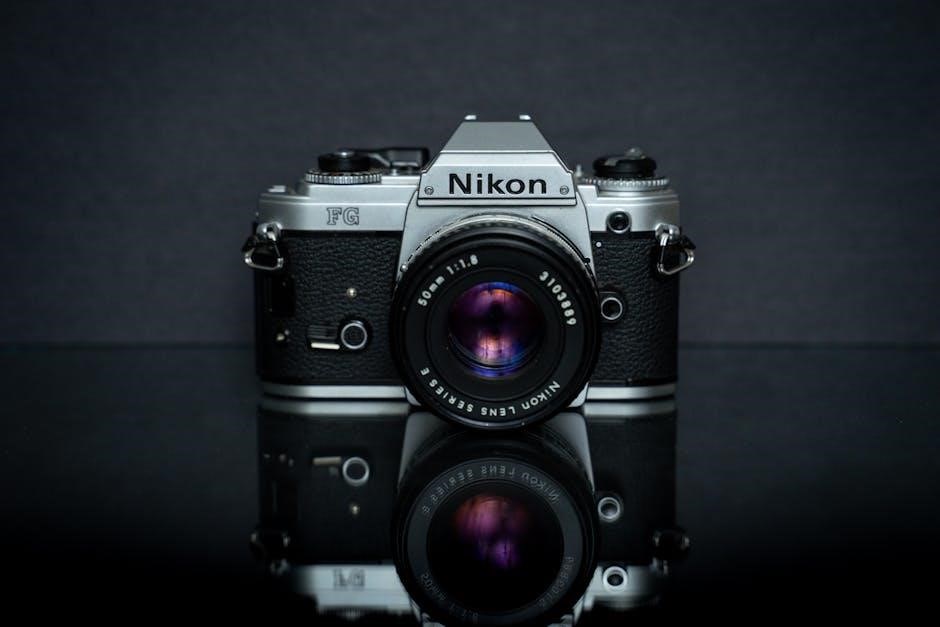
Advanced Camera Features
The Nikon D80 user manual explores advanced features like custom settings, focus modes, white balance, and metering options, empowering photographers to refine their techniques and enhance image quality.
Custom Settings and Personalization
The Nikon D80 user manual details how to tailor the camera to individual preferences through custom settings. Users can assign functions to specific buttons, saving time during shoots. The manual explains how to save personal shooting styles, such as preferred aperture or shutter speed combinations, ensuring consistent results. Additionally, it guides the customization of autofocus settings, allowing precise control over focus modes and AF-area selection. These personalization options enable photographers to streamline their workflow and adapt the camera to their unique shooting style. By leveraging these features, users can enhance creativity and efficiency, making the D80 a highly adaptable tool for diverse photographic needs.
Focus Modes and Autofocus Settings
The Nikon D80 offers versatile focus modes, including Single-Servo AF, Continuous-Servo AF, and Manual Focus. The user manual explains how to select these modes based on shooting scenarios, such as stationary subjects or fast-moving objects. Autofocus settings, like AF-Area Mode and AF-Assist, are detailed to enhance focus accuracy. Customizing AF settings allows photographers to optimize performance for specific conditions, ensuring sharp images consistently. The manual also covers troubleshooting autofocus issues, providing practical solutions to common problems. By mastering these features, users can achieve precise control over focusing, adapting to various photographic situations with ease and confidence. This detailed guidance empowers photographers to capture sharp, professional-quality images every time.
White Balance and Metering Modes
The Nikon D80 user manual provides detailed guidance on White Balance and Metering Modes, essential for achieving accurate color representation and exposure. White Balance settings, such as Auto, Daylight, and custom options, allow photographers to adjust color tones based on lighting conditions. Metering Modes, including Matrix, Center-Weighted, and Spot, help determine exposure by analyzing light in different areas of the frame. The manual explains how to select and customize these settings for various scenarios, ensuring optimal image quality. Understanding these features enables photographers to capture images with precise lighting and color accuracy, enhancing their creative control. Proper use of White Balance and Metering Modes is vital for achieving professional-looking results, making this section of the manual indispensable for mastering the D80’s capabilities.
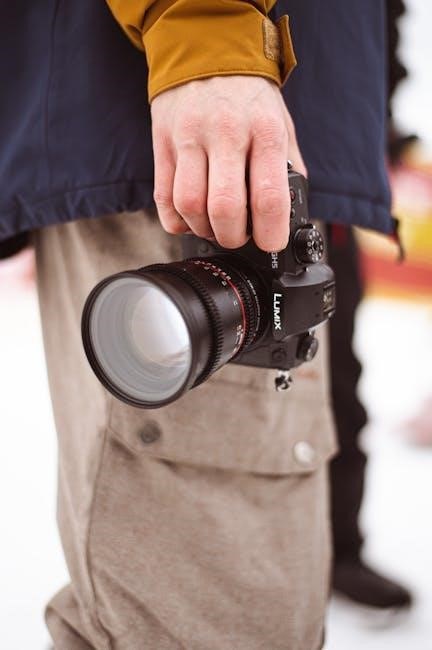
Image Quality and Settings
The Nikon D80 user manual details settings for optimal image quality, covering ISO, aperture, and shutter speed to enhance your photography experience with precision and clarity through customization.
Understanding ISO, Aperture, and Shutter Speed
The Nikon D80 user manual provides detailed guidance on mastering ISO, aperture, and shutter speed, which are fundamental for controlling exposure and achieving desired image effects. ISO sensitivity ranges from 100 to 1600, allowing photographers to adapt to varying lighting conditions while balancing noise levels. Aperture, measured in f-stops, regulates depth of field and light entry, with lower f-stops creating a shallower focus. Shutter speed, adjustable from 1/8000 to 30 seconds, captures motion blur or freezes action. The manual explains how these settings interact and offers practical examples for optimizing their use in different scenarios, ensuring photographers can confidently experiment and refine their techniques for stunning results. This section is essential for understanding the technical aspects of photography with the D80.
Image Size and Quality Settings
The Nikon D80 user manual details how to adjust image size and quality settings to suit your photography needs. The camera offers multiple image sizes, including 3872×2592 pixels for high-resolution images, and smaller sizes for more compact files. Quality settings range from Fine to Basic JPEG compression, allowing you to balance file size and image detail. The manual explains how to access these settings via the menu system and suggests optimal configurations for different shooting scenarios. Understanding these options enables photographers to manage storage efficiently while maintaining desired image quality. This section is particularly useful for those seeking to customize their workflow and ensure their images meet specific requirements, whether for professional or personal use. Proper use of these settings enhances overall image output and user satisfaction.
Noise Reduction and Image Optimization
The Nikon D80 user manual provides detailed guidance on noise reduction and image optimization techniques. It explains how to minimize digital noise in low-light conditions by adjusting ISO settings and using noise reduction features. The manual also covers optimal image optimization strategies, such as fine-tuning white balance and exposure compensation, to enhance image clarity and color accuracy. Additionally, it discusses the benefits of shooting in RAW format, which allows for greater flexibility during post-processing. These features ensure photographers can achieve professional-quality images with minimal noise and maximum detail.
By following the manual’s recommendations, users can effectively balance noise reduction with image quality, ensuring their photos are crisp and visually appealing even in challenging lighting conditions.
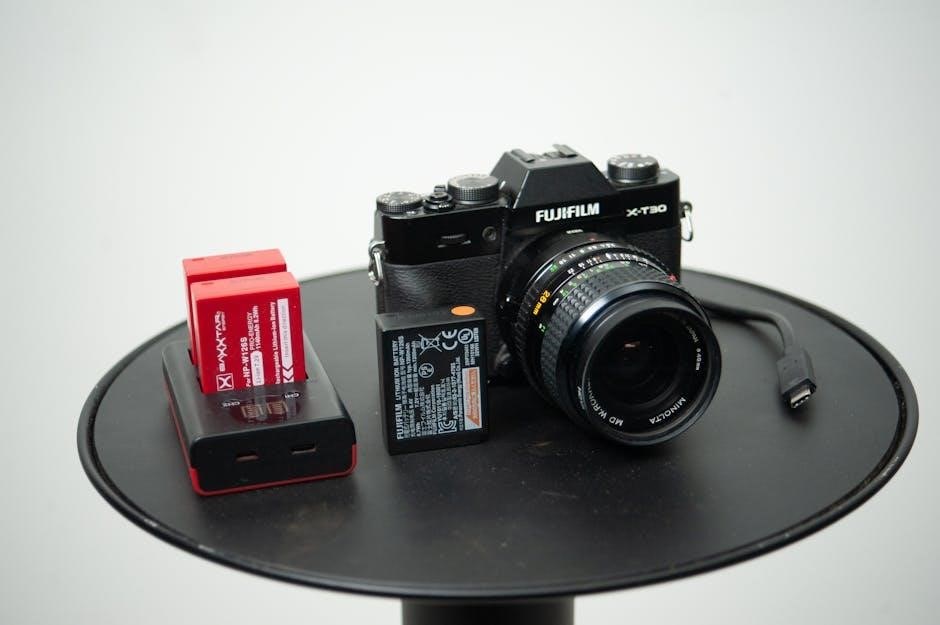
Troubleshooting Common Issues
The Nikon D80 user manual offers a dedicated section for troubleshooting, helping users identify and resolve common issues like error messages and operational problems efficiently.
Understanding Error Messages
Understanding error messages is crucial for resolving issues with your Nikon D80. The user manual provides detailed explanations of error codes, such as “Err” messages related to shutter mechanisms, and offers step-by-step solutions. These messages indicate specific problems, like obstructions or system malfunctions, guiding users to restart the camera or check components. The manual ensures users can interpret and address errors effectively, minimizing downtime and ensuring optimal camera performance; By referencing the manual, photographers can quickly identify and fix issues, enhancing their overall shooting experience. This section is essential for maintaining the camera’s functionality and capturing high-quality images without interruptions.
Resolving Common Operational Problems
The Nikon D80 user manual provides practical solutions for common operational issues, ensuring smooth photography sessions. It addresses problems like camera freezes, lens errors, or memory card issues, offering clear troubleshooting steps. For instance, if the camera freezes, the manual suggests powering it off and on or checking for firmware updates. It also guides users on resolving issues like incorrect date/time settings or autofocus malfunctions. The manual emphasizes the importance of proper camera maintenance, such as cleaning the sensor and checking battery health, to prevent operational hiccups. By following the manuals advice, users can quickly identify and fix problems, ensuring their Nikon D80 performs optimally in various shooting conditions. This section is invaluable for maintaining the cameras reliability and extending its lifespan;
Camera Maintenance and Care Tips
Regular maintenance is crucial to ensure the Nikon D80’s longevity and optimal performance. The user manual recommends cleaning the camera and lens with a soft, dry cloth to prevent dust and smudges. Avoid using harsh chemicals or abrasive materials that could damage the surfaces. For the CCD sensor, use a blower or brush to gently remove dust, as specified in the manual. Proper storage in a cool, dry place, away from direct sunlight, is advised. Additionally, the manual emphasizes the importance of updating firmware to maintain performance and fix any bugs. By following these care tips, users can protect their investment and ensure the Nikon D80 continues to deliver exceptional results over time.
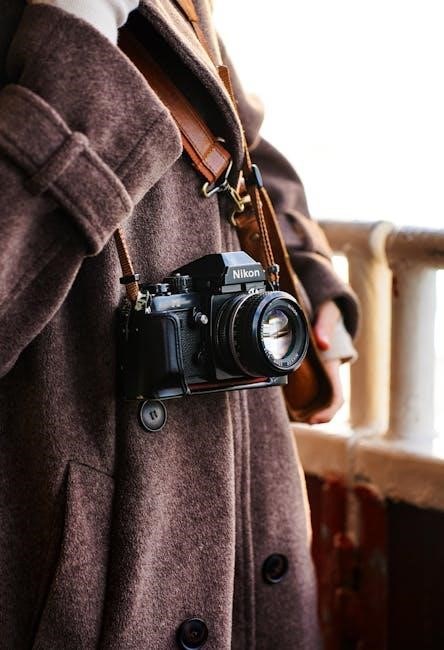
Additional Resources and Support
The Nikon D80 user manual is supported by Nikon’s official website, offering downloadable resources, firmware updates, and customer support. Online forums and communities provide additional troubleshooting tips and discussions.
Online Communities and Forums
Online communities and forums dedicated to the Nikon D80 provide valuable resources, tips, and support for users. Websites like photography forums and social media groups offer spaces to discuss camera techniques, share experiences, and troubleshoot issues. Many enthusiasts and professionals actively participate, sharing insights and solutions to common problems. These platforms also host user-generated content, including tutorials and guides, which can complement the official manual. Additionally, forums often include discussions on accessories, firmware updates, and maintenance tips. Engaging with these communities can enhance your understanding of the Nikon D80 and help you make the most of its features. They serve as a collaborative space for photographers to learn and grow together.
Official Nikon Support and Updates
Nikon provides dedicated support for the D80 through its official website, ensuring users have access to reliable resources. The official Nikon website offers downloadable PDF versions of the D80 user manual, firmware updates, and technical support. Regular firmware updates enhance camera performance, fix issues, and improve compatibility with accessories. Nikon’s customer support team is available to address queries and provide solutions for troubleshooting. The official manual is a trusted source, ensuring accuracy and completeness. Users are advised to download updates and manuals directly from Nikon’s website to avoid malware risks. This official support ensures the Nikon D80 remains a reliable tool for photographers, with continuous improvements and assistance available.
Recommended Accessories for the Nikon D80
To enhance your photography experience with the Nikon D80, consider investing in key accessories. Lenses such as the AF-S DX NIKKOR 18-55mm or 55-200mm offer versatility for various shooting scenarios. An external flash like the SB-600 or SB-800 provides better lighting control and reduces shadows. A sturdy tripod, such as the Manfrotto BeFree, ensures stability for low-light or long-exposure shots. High-capacity memory cards, like SanDisk Extreme Pro, are essential for storing large image files. Additionally, a protective camera bag, such as the Think Tank Photo Urban Disguise, keeps your gear safe during travel. These accessories complement the D80’s capabilities, helping you achieve professional-grade results and expand your creative possibilities.
The Nikon D80 user manual is an essential resource for mastering this versatile DSLR, offering insights to unlock its full potential and enhance your photographic journey.
Maximizing the Potential of the Nikon D80
To unlock the full potential of the Nikon D80, it is essential to explore its advanced features and customize settings according to your needs. Experiment with aperture, shutter speed, and ISO to achieve creative control over your images. The camera’s robust build and intuitive interface make it ideal for both beginners and professionals. Regularly referencing the user manual ensures you stay updated on optimal techniques and troubleshooting tips. By mastering the D80’s capabilities, you can elevate your photography skills and produce stunning results. Continuous learning and adaptation to the camera’s features will help you capture moments with precision and artistry.
Continuous Learning and Improvement
Continuous learning and improvement are key to harnessing the full potential of the Nikon D80. The user manual serves as a valuable resource for photographers at all skill levels, offering insights into both basic and advanced functionalities; Regularly revisiting the manual ensures that users stay informed about optimal settings and techniques, enabling them to refine their skills over time. By exploring new shooting modes, experimenting with customization options, and understanding advanced features, photographers can continuously enhance their creative output. This ongoing process of learning and adaptation not only deepens mastery of the camera but also fosters artistic growth and the ability to capture images with greater precision and flair.
Final Thoughts on the Nikon D80 User Manual
The Nikon D80 user manual is an indispensable tool for photographers seeking to maximize their camera’s capabilities. It provides clear, detailed guidance on everything from initial setup to advanced techniques, ensuring users can navigate the camera’s features with confidence. Whether you’re a novice or an experienced shooter, the manual offers valuable insights and practical advice. Its structured approach makes complex concepts accessible, fostering a deeper understanding of photography fundamentals. By referencing the manual regularly, users can continue to refine their skills and explore new creative possibilities. Ultimately, the Nikon D80 user manual is not just a reference but a partner in your photographic journey, helping you unlock the full potential of this versatile and powerful camera.
